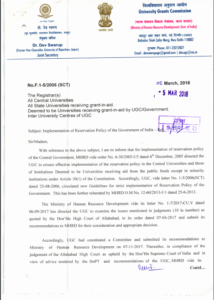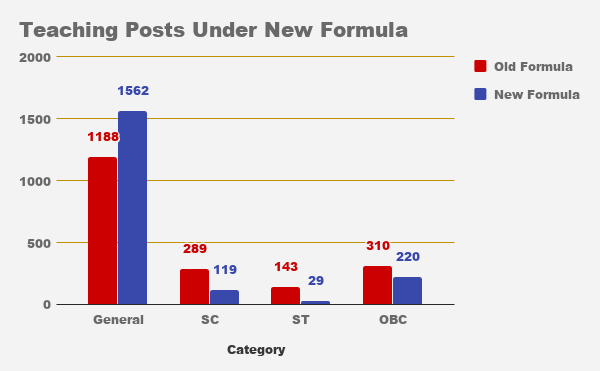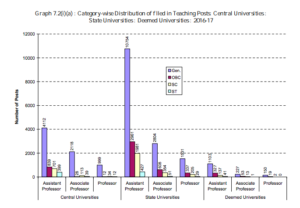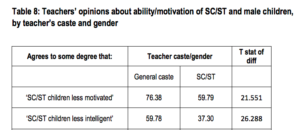Co-authored by Evita Rodrigues and Charith Reddy
A recent proposal by the University Grants Commission (UGC) to alter the method of calculating the number of reserved faculty positions has incited controversy on the grounds that it allegedly seeks to circumvent the system of reservation mandated by the Constitution. Amid heavy criticism, the Central Government filed a review petition before the Supreme Court to revoke the new proposal and return to the previous formula of calculating reserved vacancies. It also directed the UGC to ask all concerned universities to postpone ongoing faculty recruitment until the petition is adjudicated. This turnaround raises questions over how the ministry and the UGC went on to implement the new policy without examining its full implications.
The UGC Proposal: A Numbers Game?
Under India’s reservation system, the SC/ST/OBC categories are entitled to 15%, 7.5% and 27% of public sector jobs respectively. Following an Allahabad High Court verdict in April 2017 wherein the method of reserving teaching posts at universities was challenged, the UGC proposed to change how the number of reserved faculty positions was calculated.

Dated 5th March 2018, this proposal directs all central, state universities and deemed-to-be universities (which receive grant-in-aid) as well as Inter-University Centres of the UGC to treat each department in an educational institution as a unit on which reservation is applicable, rather than treating the whole institution as a unit.
This alters the number of positions to be reserved. When there are more than thirteen vacancies open in a cadre, the number of reserved posts for SC/ST/OBC candidates is derived by multiplying the strength of the cadre by the prescribed reservation percentage for each category. However, when there are less than fourteen vacancies, reserved positions are decided by rotation. The 7th position is reserved for SCs, the 14th for STs and every 4th position is reserved for OBCs.
The mathematics of determining quotas ensures that only when a minimum of fourteen appointments are made will every reserved category be represented in at least one position
For the most part, the proposal has been heavily criticised. In an interview with The Bastion, Dr. Khora (School of Education, TISS Mumbai) asserts that the proposal is a means of bypassing the reservation system: “In theory the court has not abolished reservations but in practice basically it will amount to an indirect sort of abolition because there will hardly be [any reservation] in departments with 10 posts.”
Like Dr Khora, many believe that such a proposal will allow many smaller departments to evade reserving seats, and will also in effect reduce the number of seats actually available for reservation. Earlier, the practice of making department-wise rosters was explicitly prohibited in clause 6(c) of the UGC Guidelines (2006), which states that such a system “tends to create single posts or cadres with an artificially reduced number of posts in order to avoid reservation.”

However, some people choose to focus on the long-term gains. Dr Madan (Azim Premji University) contends that in the long run, “it [the policy] will ensure that reserved positions do not cluster in just one department and will overcome the present anomaly of seats being reserved in some departments but not in others.”

Making a Case for Reservation
The heated debate on the effects of the new proposal stems from the integral socio-political purposes of reservation in India. Reservation seeks to provide marginalised communities with access to cultural capital, as well as representation in the public sphere. The new proposal impacts not only the employment opportunities of faculty belonging to SC/ST/OBC categories but also the higher education pedagogy and system.
What’s in it for students?
Preliminary research suggests that ensuring the presence of teachers from SC/ST/OBC categories significantly enhances the learning experience of students belonging to these communities. A working paper submitted in 2010 at the Institute of Education, University of London found that a teacher’s background characteristics (i.e. gender, caste, and religion) are related to and influence the manner in which the teacher facilitates student learning.

While the findings of this working paper are provisional, they could have important implications for education policy. For instance, general category teachers were revealed to have significantly more negative attitudes (than SC/ST teachers) towards scheduled caste and scheduled tribe children.
This strongly suggests that the threat of discrimination and stereotyping makes it detrimental for a reserved category student to be taught by a general category teacher, calling for greater diversity. On similar lines, Dr Thorat (from JNU) tells us that “teachers from different communities will ensure a sense of comfort and confidence [for students] while also serving as role models.”
But this may not be enough to improve the learning environment at universities. Taking into account a study conducted in 2005 which argues that recruiting teachers due to their caste, gender, and/or religion does not ensure that they will have the qualities required for effective teaching, Rawal and Kingdon’s working paper asserts that teaching must be made a more inclusive profession even though high-quality teachers, irrespective of their background, must be hired. They suggest implementing specific policies directed at (1) promoting neutral attitudes towards varying demographics/communities; (2) training to reduce discriminatory preconceptions and practices in classrooms; and, (3) revamping learning resources to ensure impartiality.
Academics Speak: What Does Reservation Do?
In an email exchange, Dr Ashwini Deshpande of Delhi School of Economics stated that “ Recruiting effective and high-quality teachers is a major challenge for higher education in India, and we have to think of ways of overcoming this challenge. However, this challenge is unrelated to the reservation system, despite myths to the contrary.”
Speaking with The Bastion, prominent academic and writer Madhu Kishwar asserts that the existing reservation system is flawed and has become a “liability” in higher education. She emphasised the need to focus on quality primary education for all: “Affirmative action is very necessary, but where it will really help is putting people on par right from the primary education level. You can improve your school education and end reservations – [because] you won’t need them.”
However, many argue that diminished ability or lesser merit in marginalised communities is not the reason for their exclusion. As Dr Thorat extols, “Even if everyone got great public sector education, reservations would still be necessary. Discrimination is based on identity… Reservation is to counter the bias, prejudice and the bigotry that exists in the society by people who are already elite and educated and in positions of power who select people to colleges or jobs and can pick and choose people.”
Additionally, he asserts the importance of representation at institutions of learning because “education is not just about mugging up something but putting it into a context and situating it into a culture”. Dr Deshpande adds, “reservations ensure that the composition of the teaching body roughly mirrors the underlying composition of the population. That is a big plus and must be maintained.”
The Takeaway
If we seek to reduce schooling gaps — particularly those based on gender, caste and other identities — it is imperative that opportunities are provided for groups that have suffered discrimination in the past. Reservation within faculty bodies involves a dual concern: addressing the underrepresentation of teachers from minority communities, as well as educating students with a balanced representation of society in all its diversity.
So while the reservation system aims to deliver on several fronts, it is also essential to evaluate how effective the manner of implementation has been in fulfilling these stated aims. Not only is this a matter of rights and representation, but it also has fundamental pedagogical impacts. A comprehensive analysis that considers all factors and stakeholders is essential before making any such policy decisions. Hopefully, the government’s next move will be carefully calculated.
![]() Pixabay | CC0
Pixabay | CC0






